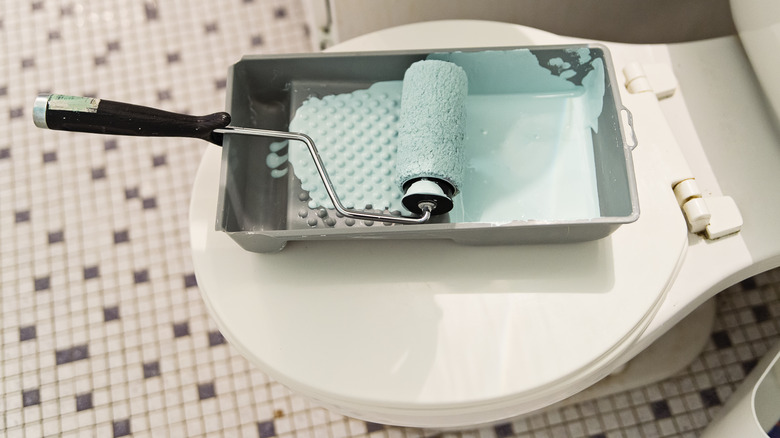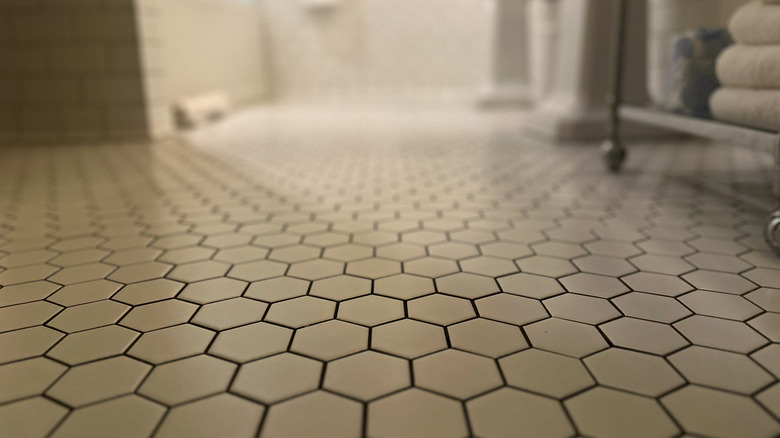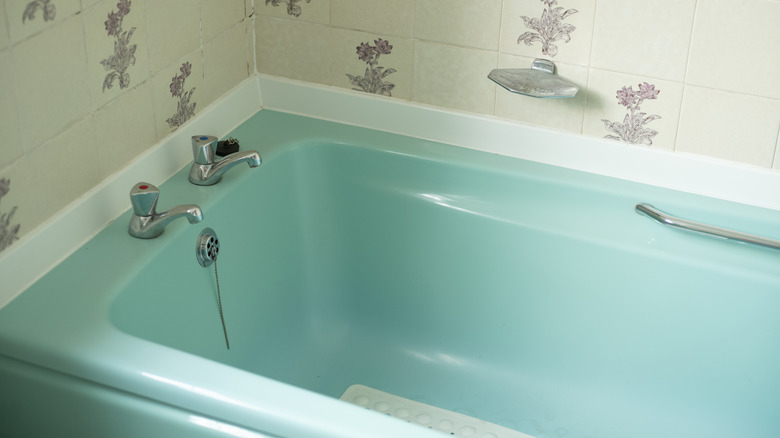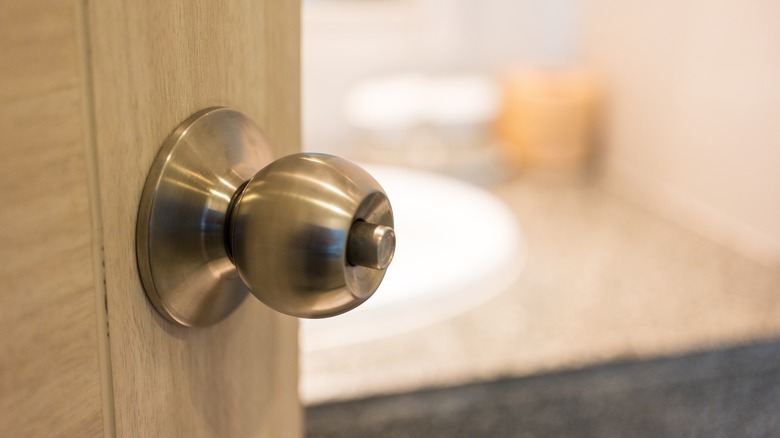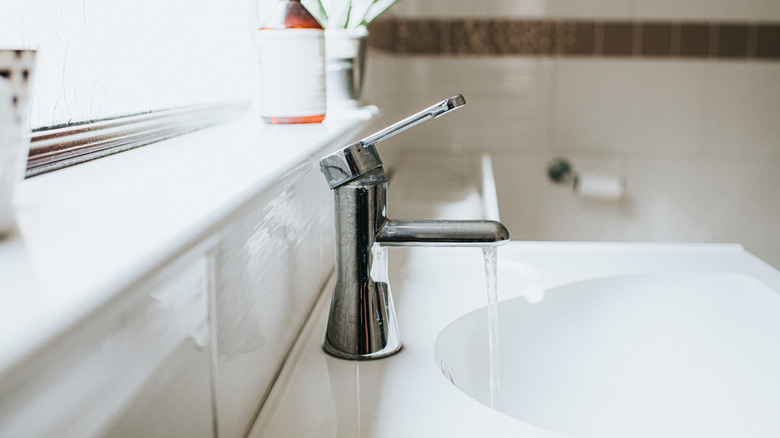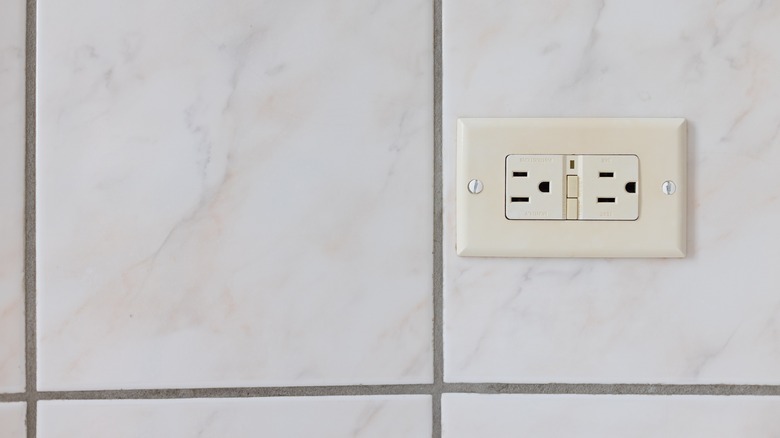Things You Should Never Paint In The Bathroom
We may receive a commission on purchases made from links.
Choosing the right paint color for your bathroom can make it look expensive, but painting the wrong surfaces can do the opposite and lead to costly problems. Paint deteriorates faster on some bathroom surfaces than others. When it starts to wear away, your home is more susceptible to rot and structural damage. If your house is on the market, peeling paint can even discourage prospective homebuyers from making an offer. In general, don't paint bathroom surfaces that experience heavy use. This rapidly strips away the paint. Also avoid anything that encourages paint to bubble, crack, or chip. The main culprit for these issues is moisture, especially the humidity showers create.
Humidity can impair paint's ability to stick to various surfaces and interfere with the drying process, among other problems. When painting a bathroom that's prone to humidity, you should use products that can handle a significant amount of moisture. Consider paint that deters mold and mildew, both of which grow in warm, damp places — for example, Zinsser Satin Perma-White Mold- and Mildew-Proof Interior Paint. Even if your paint is suitable for a humid space, there are some things you shouldn't use it on in your bathroom. Bathroom flooring is one item in your house that you typically shouldn't paint.
Flooring
Bathroom flooring is constantly getting wet and trampled. This can spell disaster for almost any paint you put on it, even if you apply multiple coats. The moisture makes the paint ripple and crack, while the frequent foot traffic causes wear and tear. Plus, many bathroom floors are made of tiles, which can be especially tricky and labor intensive to paint. Getting ready to paint tiles involves cleaning, sanding, priming, and more. After all of that work, finding that your paint doesn't stick to the tiles is likely to be frustrating.
Instead of painting your bathroom floors, consider replacing them if they're looking lackluster. Luxury vinyl plank, or LVP, is popular among homeowners seeking bathroom flooring that can handle lots of use and the challenges moisture presents. Many types are suitable for DIY remodeling projects, and there are all kinds of style and color choices. In other words, if customization is important to you, vinyl plank flooring may be right for your space.
Bathtubs
Coating an old, dingy bathtub in fresh, glossy paint may seem like the hack of the century, but this update isn't likely to hold up for long. Even if it looks good at first, most interior paints, even waterproof ones, won't tolerate frequent water contact or temperature shifts. A tub that's used often is also subject to wear-related issues like those the bathroom flooring faces.
If you want to give your tub a makeover, consider reglazing it. This process involves fixing small cracks, rust stains, and other cosmetic issues with a tough epoxy. Many people hire a pro to do it, but you can try it on your own with a reglazing kit. One option, the Armoglaze DIY Bathtub Refinishing Kit with Odorless Epoxy Coating, is designed for use on porcelain, fiberglass, and cast iron tubs. Replacing your tub is another option, but a more expensive one because plumbing work is involved.
Knobs and handles
Doorknobs and handles are made to be touched, and the more you touch them, the more the paint will slough off. Avoid painting them in your bathroom and everywhere else in your house, too. This includes drawer pulls and other hardware you use to open and close bathroom storage compartments. Try painting a shiny metal knob or handle, and you may also notice another problem: paint's reluctance to stick to this nonporous surface. A more serious problem can happen with knobs and handles that lock. If paint gets into the locking mechanism, it can stop working, locking you out of the bathroom when you need it. Even worse, you could get locked in.
If you want to update the knobs and handles in your bathroom, replacing them may be the easiest route. This is typically a DIY-friendly project, and doing the work yourself can save you money. Another option is hiring a pro to refinish knobs, handles, and other items in your bathroom that are made of the same material. This might be the best option if you own a historic home or adore the style of your existing hardware.
Faucets
Remember how paint often won't stick to shiny metal knobs and handles? It behaves similarly with the shiny metal of bathroom faucets. Even if you can make your paint stick to a faucet, getting used and splashed repeatedly will strip the paint away in no time. You're better off swapping unappealing faucets for new ones that better reflect your taste.
When shopping for bathroom sink components, be sure to determine whether single- or double-handle faucets are better for your home. Taking a close look at each faucet's installation requirements is key. Before loading up your shopping cart, decide if you want your bathroom sink's faucet and handles to be the same material, color, or sheen as the doorknobs and drawer handles. If you're also picking out a new shower head, its finish is a key consideration. You may want its finish to look similar to that of the bathroom faucet, the light fixtures, or other elements of your bathroom.
Electrical outlets
Electrical outlets tend to get used on the regular, which makes any paint you put on them likely to chip and peel. That said, the biggest reason to avoid painting them involves safety. If paint gets in a power socket, it can create a blockage that makes it impossible to use. It can also disrupt how a plugged-in appliance and the electricity source interact with each other, potentially causing a short circuit. Your outlets are probably capable of sending out sparks, and some paints are quite flammable, especially spray paint. Considering this, it's wise to keep paint away from them. If an outlet you painted starts sparking, a full-blown fire could develop faster than expected.
Even if paint helps your outlets blend into the walls, the risk is not worth it. Replace your electrical outlets and their faceplates if you want to change how they look, and put your painting skills to use on your bathroom walls instead. When doing so, be sure to avoid common bathroom painting mistakes such as forgetting to scrub the walls and neglecting to scrape away cracked or chipped paint.
